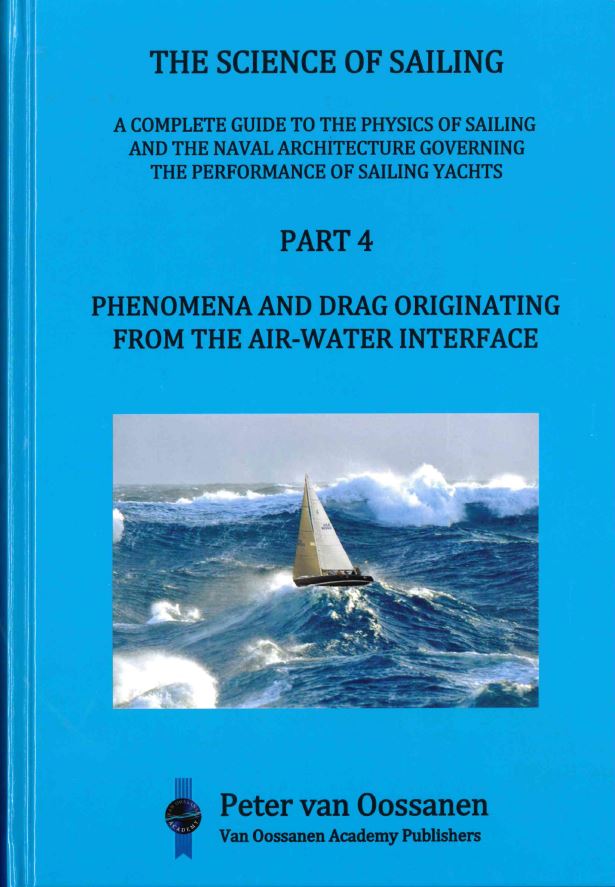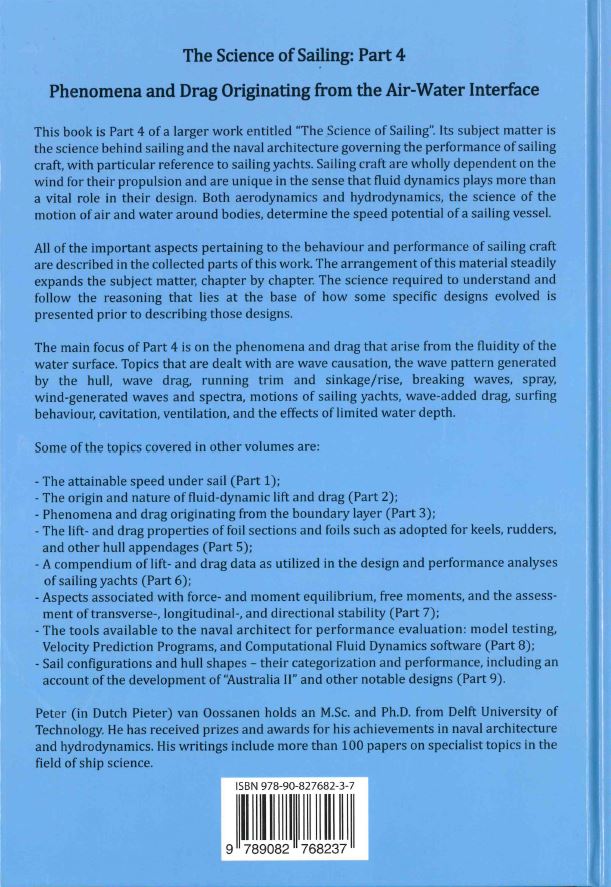Inspiration
(note from Peter)
Describing the phenomena that occur at the interface between water and air, as well as their effect on hull resistance, has produced a unique book. Never before has anything of this nature been published. This in itself provided the inspiration that spurred me on to write Part 4. The large number of topics that needed to be covered has led to a book with 558 pages.
Part 4 consists of two chapters. Chapter 8 is devoted to the phenomena and drag originating from the air-water interface, with little reference to water depth. The different treatment of relevant subjects in water of restricted depth has been collected and transferred to Chapter 9. As I explained in Part 3, I have divided the subject matter associated with drag into viscous drag (Part 3) and the drag associated with the presence of the air-water interface in this volume.
Chapter 8 commences with a description of the process by which surface waves are formed by a body progressing at some speed at the air-water interface, and the consequences of such waves on the drag of that body. The example of a submarine-like body, rising to the surface from a depth at which no surface waves are formed, is utilized to pin-point features of the wave-generation process that would otherwise not be distinguishable. The following section is dedicated to the derivation of the properties of regular surface waves in deep water. The derivation of the wave pattern generated by a body travelling at a fixed speed on the water surface is realized by a mathematical model that is based on replacing the hull by a pressure disturbance acting at a point. Two such derivations are described. Both methods are seen to lead to the well-known Kelvin wave pattern.
The important subject of wave drag the most important component of drag in the case of sailing craft at higher speeds, commences with a formal definition of wave drag and how this component can be determined. The energy flux of the transverse wave system is adopted to derive an expression for the wave drag of the hull that generated that wave system. The interference of the wave systems, separately generated by the bow and the stern of the hull, is then addressed by modelling each of these wave systems by singular pressure points. This leads to a quantification of what naval architects call “humps” and “hollows” in the (wave) drag curve. Extensive use of the Kelvin wave pattern requires that its accuracy is examined. The comparison with the results of CFD calculations, leads to a satisfactory result and a “surprise” regarding a feature exhibited by the Kelvin pattern that is not so obvious from CFD results.
The subject of breaking waves is treated in terms of their nature and the differentiation in types, followed by breaking criteria, and the resulting drag when a hull generates breaking waves. The spray thrown up by high-speed hulls and hull appendages is also considered. The focus here is on its nature and manifestation, its quantification, its effect on drag, and on spray deflection.
Wind-generated waves are dealt with in detail. To do justice to this important subject, significant space has been allotted to an extended description of the methods adopted to describe a confused sea. The prediction of wave height and wave period, based on wind strength, wind duration along the fetch, and fetch length, are treated in detail because of the use that is made of this prediction by naval architects. The motions exhibited by sailing yachts are extensively described, as is also the calculation of the mean wave-added drag. The surfing behaviour of sailing yachts in following seas is then considered. The approach to this subject is new, as are the results obtained by the adopted method.
Cavitation and ventilation are the last two subjects covered in Chapter 8. Both of these topics are described in terms of a description of the fundamental processes involved, a description of the occurring types, their effects, and their suppression.
The two subjects that need separate treatment in the context of the effect of water of restricted depth, are wave generation and wave drag. Chapter 9 is mainly concerned with these two subjects.

Blurb text
This book is Part 4 of a larger work entitled “The Science of Sailing”. Its subject is the science behind sailing and the naval architecture governing the performance of sailing craft, with particular reference to sailing yachts. Sailing craft are wholly dependent on the wind for their propulsion and are unique in the sense that fluid dynamics plays more than a vital role in their design. Both aerodynamics and hydrodynamics, the science of the motion of air and water around bodies, determine the speed potential of a sailing vessel.
All the important aspects pertaining to the behaviour and performance of sailing craft are described in the collected parts of this work. The arrangement of this material steadily expands the subject, chapter by chapter. The science required to understand and follow the reasoning that lies at the base of how some specific designs evolved is presented before describing those designs.
The main focus of Part 4 is on the phenomena and drag that arise from the fluidity of the water surface. Topics that are dealt with are wave causation, the wave pattern generated by the hull, wave drag, running trim and sinkage/rise, breaking waves, spray, wind-generated waves and spectra, motions of sailing yachts, wave-added drag, surfing behaviour, cavitation, ventilation, and the effects of limited water depth.
Some of the topics covered in other volumes are:
- The attainable speed under sail (Part 1);
- The origin and nature of fluid-dynamic lift and drag (Part 2);
- Phenomena and drag originating from the boundary layer (Part 3);
- The lift- and drag properties of foil sections and foils such as adopted for keels, rudders, and other hull appendages (Part 5);
- A compendium of lift- and drag data as utilized in the design and performance analyses of sailing yachts (Part 6);
- Aspects associated with force- and moment equilibrium, free moments, and the assessment of transverse-, longitudinal-, and directional stability (Part 7);
- The tools available to the naval architect for performance evaluation: model testing, Velocity Prediction Programs, and Computational Fluid Dynamics software (Part 8);
- Sail configurations and hull shapes – their categorization and performance, including an account of the development of “Australia II” and other notable designs (Part 9).
Peter (in Dutch Pieter) van Oossanen holds an M.Sc. and Ph.D. from Delft University of Technology. He has received prizes and awards for his achievements in naval architecture and hydrodynamics. His writings include more than 100 papers on specialist topics in the field of ship science.

Purchase information
The book is published by Van Oossanen Academy Publishers, and produced by Buijten & Schipperheijn b.v. in Amsterdam. It has a hard cover. The book comprises 558 pages. Its ISBN number is 978-90-827682-3-7. The book is sold by all major bookshops. It can also be ordered directly from Van Oossanen Academy Publishers. The following link is provided for that purpose.